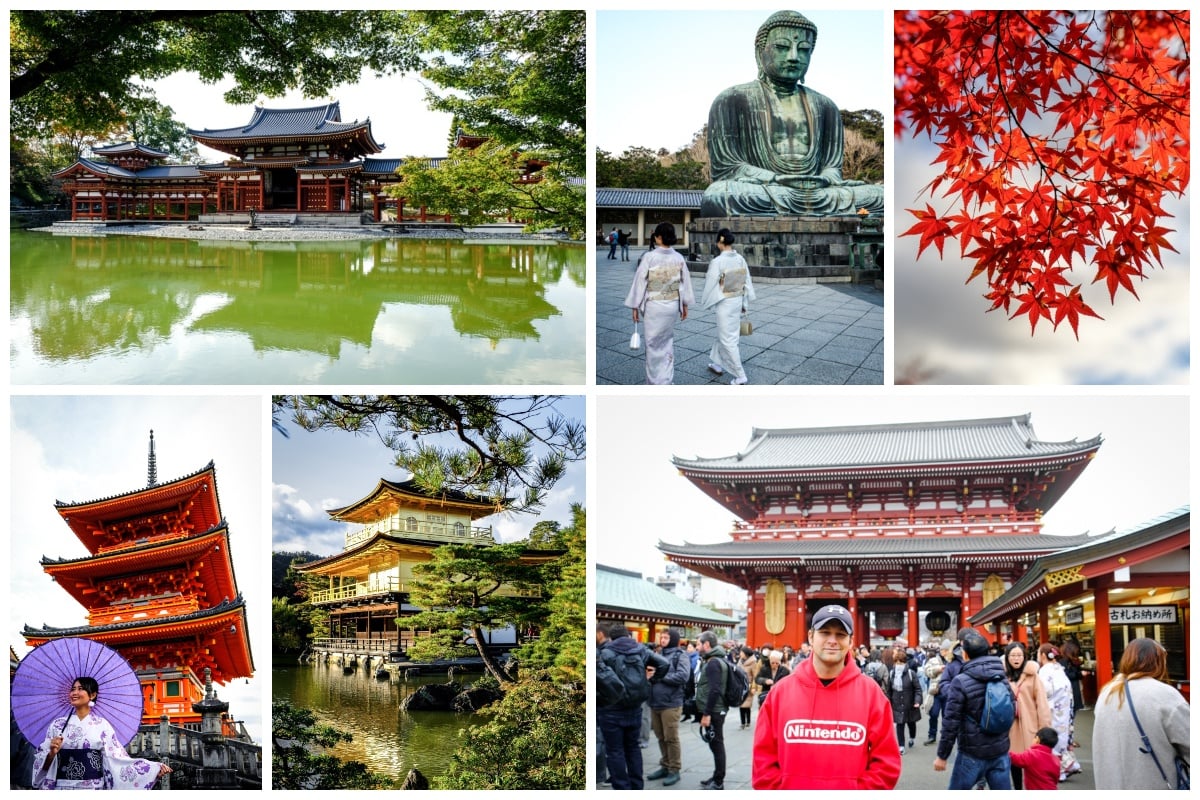Summary
After numerous visits to Japan over the years, I’ve compiled this Japanese temple & shrine guide to help you discover some of the best ones!
With over 160,000 traditional Japanese temples and shrines scattered across the ‘Land of the Rising Sun,’ these sites often boast fascinating histories and the buildings themselves are true works of art.
Kyoto, Japan’s ancient capital and cultural center, hosts most of the famous shrines as well as many of the best temples to visit. You can also find impressive ones in and around Tokyo.
Read on for my complete Japanese temple guide!
Where To Stay In Kyoto




Best Traditional Shrines & Temples In Japan
1. Todai-ji Temple (Nara)
Todai-ji Temple stands as one of Japan’s most spectacular landmarks, with rich history behind it. This massive ancient structure was the world’s largest wooden building for a millennium and houses the biggest bronze Buddha statue globally.

In Nara Park, you’ll find other traditional temples and shrines to explore. The main building of Todaiji, completed in 752 AD, was originally 30 percent larger than the existing structure.

2. Kinkaku-ji Temple (Kyoto)
The Kinkaku-ji Temple, also known as the Golden Pavilion, is an iconic site and is the #1 most visited tourist destination in Kyoto. This remarkable spot is a photographer’s dream, particularly on calm mornings.
3. Ginkaku-ji Temple (Kyoto)
After Kinkaku-ji, consider visiting Ginkaku-ji, the Silver Pavilion, located in eastern Kyoto. This temple dates back to the 15th century and features a dry sand garden styled to resemble Mount Fuji.
4. Tenryu-ji Temple (Kyoto)
Built in the 14th century, Tenryu-ji Temple is in Kyoto’s Arashiyama district and is famous for its stunning landscape gardens and vibrant fall colors.
5. Senso-ji Temple (Tokyo)
Sensoji is the oldest and most renowned temple in Tokyo, established in the 7th century. It features a giant Torii gate, a five-story pagoda, and spectacular main temple building.

6. Kawasaki Daishi Temple (Tokyo)
Kawasaki Daishi might not be as daunting as Sensoji, but it showcases impressive architecture and a vibrant local atmosphere with countless shops.

7. Hase-Dera Temple (Kamakura)
This shrine boasts many intriguing statues, including a towering 9-meter Kannon figure. It also offers breathtaking views over the city.

8. Arakura Sengen Shrine (Fuji)
The shrine features the stunning Chureito Pagoda, a remarkable sight against the backdrop of Mount Fuji, one of Japan’s most recognizable icons.
9. Fushimi Inari Shrine (Kyoto)
Fushimi Inari Shrine, renowned for its iconic 1,000 orange torii gates, is ideal for hiking and photography. Visit in the early morning for fewer crowds.

10. Kiyomizu-dera Temple (Kyoto)
Known for its picturesque pagoda and vibrant fall colors, Kiyomizu-dera Temple is a must-see for visitors exploring Kyoto.
11. Byodo-in Temple (Uji)
This underrated temple is featured on the Japanese 10 yen coin and has a twin in Hawaii, sharing architectural similarities.

12. Yasaka Pagoda (Kyoto)
The Yasaka Pagoda stands prominently in the Higashiyama district and is part of a temple dating back to the 6th century.

13. Great Buddha Statue (Kamakura)
Famous for its open-air bronze statue, the Great Buddha in Kamakura is an iconic landmark easily accessible from Tokyo.

Japanese Temple Etiquette
- Remain calm and respectful, avoiding noisy behavior.
- Be prepared to remove your shoes when entering temple buildings.
- Photography is usually permitted outside; check for any restrictions inside buildings.
- Many temples have free entry, with fees typically below 500 Yen ($5 USD) for those that do charge.
- Consider wearing a rented kimono for a culturally immersive experience!
Best Time To Visit
The cherry blossom and autumn seasons are particularly stunning but expect larger crowds. Early mornings and late afternoons generally provide a calmer experience.






